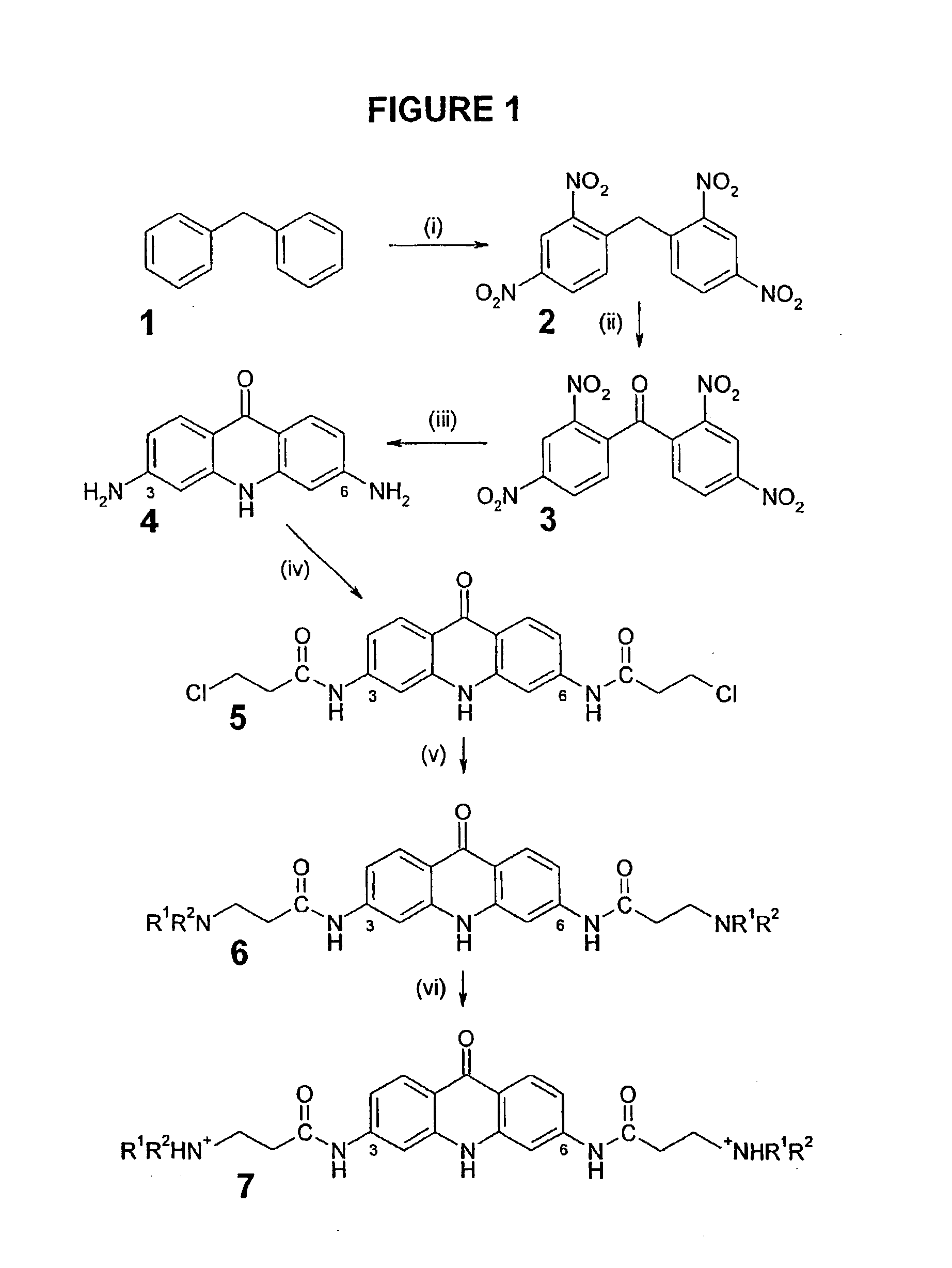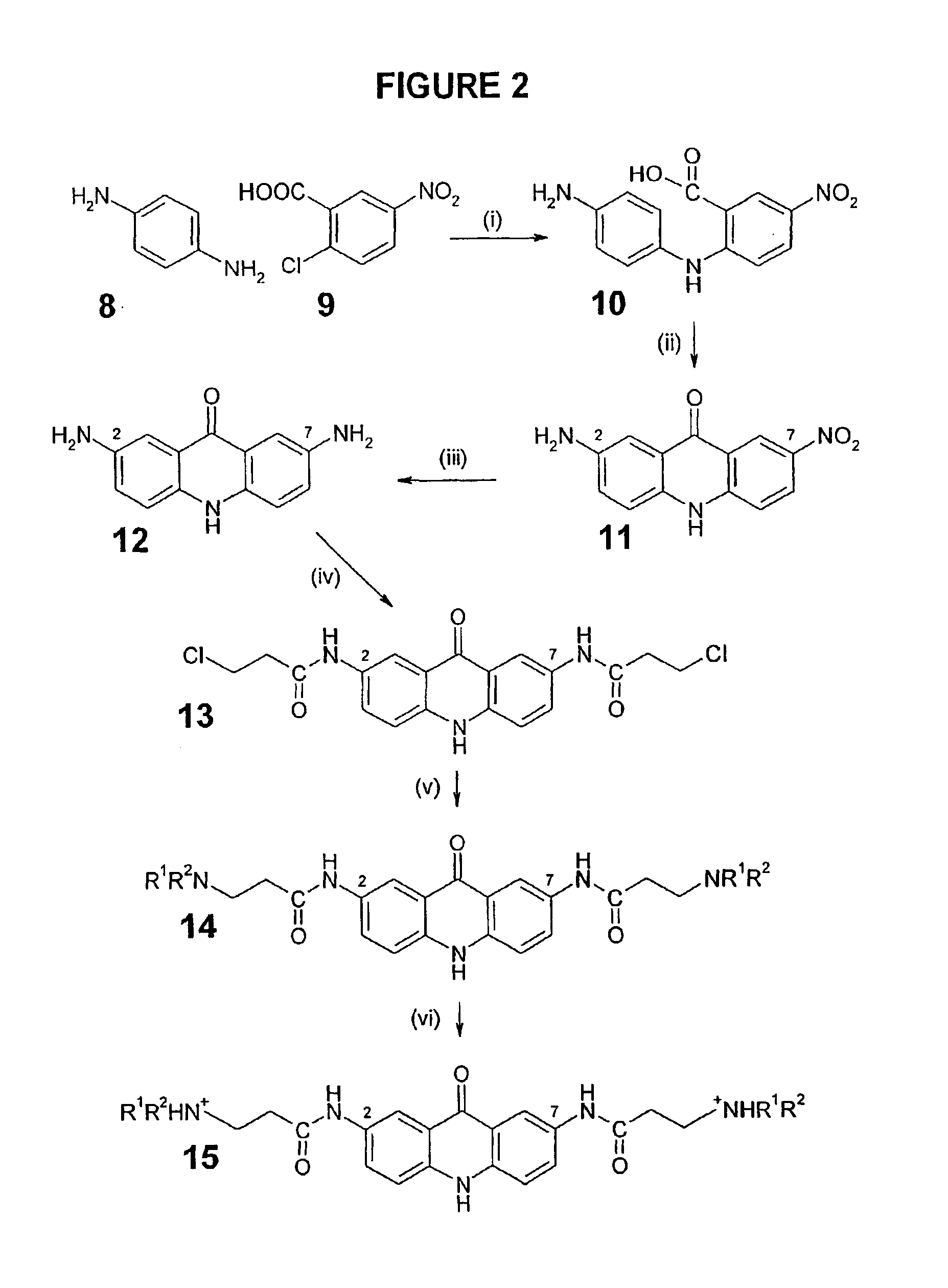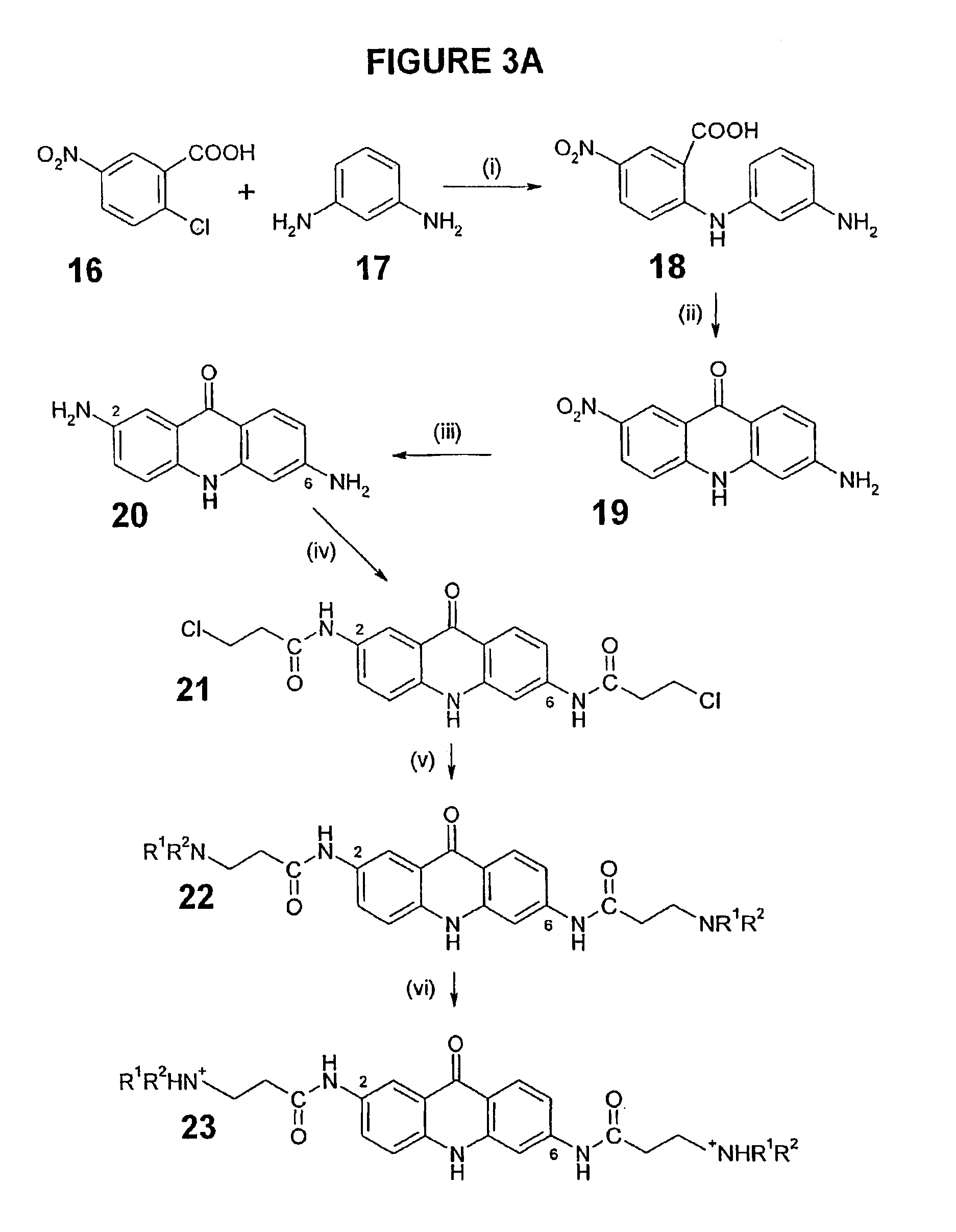Therapeutic acridone and acridine compounds
a technology of acridine and acridine, which is applied in the field of telomerase inhibitors and antiproliferative agents, can solve the problems of unrepaired 3′-dna, limit the number of replicatives, and stage for a potential “end-replication problem
- Summary
- Abstract
- Description
- Claims
- Application Information
AI Technical Summary
Benefits of technology
Problems solved by technology
Method used
Image
Examples
examples of specific embodiments
[0211]Some individual embodiments of the present invention include the following compounds:
[0212]
# Free BaseClassHCl SaltStructure2,6,9-ine1 BSU-SB-36 / 188 SB-ACI-182,6,9-ine2 BSU-SB-36 / 190 SB-ACI-192,6,9-ine3 BSU-SB-36 / 194 SB-ACI-172,6,9-ine4 BSU-SB-36 / 196 SB-ACI-222,6,9-ine5 BSU-SB-36 / 198 SB-ACI-202,6,9-ine6 BSU-SB-36 / 200 SB-ACI-212,6,9-ine7 BSU-SB-36 / 202 SB-ACI-162,6,9-ine8 JH-ACI-104 JH-ACI-1052,6-one9 AR-ACO-10 AR-ACO-112,7,9-ine10 JM-ACI-10 JM-ACI-112,7,9-ine11 JM-ACI-29 JM-ACI-302,7,9-ine12 JM-ACI-31 JM-ACI-322,7,9-ine13 JM-ACI-33 JM-ACI-342,7,9-ine14 JM-ACI-35 JM-ACI-362,7,9-ine15 JM-ACI-37 JM-ACI-382,7,9-ine16 JM-ACI-39 JM-ACI-402,7,9-ine17 JM-ACI-41 JM-ACI-422,7,9-ine18 JM-ACI-45 JM-ACI-462,7-one19 BR-ACO-16 BR-ACO-92,7-one20 BR-ACO-17 BR-ACO-102,7-one21 JH-ACO-23 JH-ACO-222,7-one22 JH-ACO-27 JH-ACO-282,7-one23 JM-ACO-06 JM-ACO-072,7-one24 JM-ACO-08 JM-ACO-092,7-one25 JM-ACO-11 JM-ACO-123,6,9-ine26 BR-ACO-21 BR-ACO-193,6,9-ine27 BR-ACO-22 BR-ACO-203,6,9-ine28 BSU-SB-36 / 152 ...
example 1
2,2′,4,4′-Tetranitrodiphenylmethane (2)
[0462]
[0463]Potassium nitrate (54.00 g, 0.53 mol) was added in portions to stirred concentrated H2SO4 (200 mL) whilst maintaining the temperature below 20° C. Diphenylmethane 1 (20.00 g, 0.12 mol) was added dropwise over 1.5 hr at 15° C. to give a brown mixture. Upon complete addition the mixture was heated to 70° C. for 40 min and produced a deep red solution. On cooling, the liquor was poured into ice and the light brown solid produced collected. This solid was washed with H2O (2×200 mL) and boiled with EtOH (300 mL) to afford the product 2 (33.83 g, 82%) as a cream solid.
[0464]Mp 170-173° C. (lit. 173° C.); 1H-NMR (CDCl3) δ 4.87 (s, 2H, CH2), 7.41 (D, 3J=8.5 Hz, 2H, H-6 / 6′), 8.44 (dd, 3J=8.5 Hz, 4J=2.4 Hz, 2H, H-5 / 5′), 8.97 (d, 4J=2.4 Hz, 2H, H-3 / 3′); MS [EI] (relative intensity %) m / z 346 ([M].+, 41), 331 (48), 303 (57), 302([M-NO2].+, 38), 300 (41), 268 (60), 285 (37), 256 ([M-N2O4].+, 19), 255 (29), 254 (64), 253 (24), 240 (32), 239 (100)...
example 2
2,2′,4,4′-Tetranitrobenzophenone (3)
BR-ACO-1
[0465]
[0466]To a refluxing solution of 2 (68.00 g, 0.20 mol) in glacial AcOH (100 mL) was slowly added CrO3 (100.00 g, 1.00 mol) during 45 min, and the mixture refluxed for 3 hr. On cooling, the product was poured into water (3000 mL) and the resultant precipitate collected, washed with H2O (2000 mL), EtOH (2×100 mL) and Et2O (2×100 mL) to furnish the ketone 3 (66.40 g, 94%) as a cream solid.
[0467]Mp 236-238° C. (lit. 232° C.; Matsumura, 1929); 1H-NMR (d6-DMSO) δ 8.03 (d, 3J=2.0 Hz, 2H, H-6 / 6′), 8.65 (dd, 3J=8.5 Hz, 4J=2.1 Hz, 2H, H-5 / 5′), 8.96 (d, 4J=2.1 Hz, 2H H-3 / 3′); MS [EI ] (relative intensity %) m / z 363 ([M+H].+, 6%), 346 ([M-O].+, 52), 316 ([M-NO2].+, 100), 270 (28), 242 (16), 196 ([C7H4N2O5].+, 54), 195 ([C7H3N2O5].+, 100) 179 ([C7H4N2O4].+, 71), 149 ([C7H3NO3].+, 85), 103 ([C7H3O].+, 82), 75 ([C6H3].+, 100). Found C, 43.13; H, 1.52; N, 15.38%. C13H6N4O9 (M=362.22) requires C, 43.13; H, 1.52; N, 15.47%.
PUM
 Login to View More
Login to View More Abstract
Description
Claims
Application Information
 Login to View More
Login to View More - R&D
- Intellectual Property
- Life Sciences
- Materials
- Tech Scout
- Unparalleled Data Quality
- Higher Quality Content
- 60% Fewer Hallucinations
Browse by: Latest US Patents, China's latest patents, Technical Efficacy Thesaurus, Application Domain, Technology Topic, Popular Technical Reports.
© 2025 PatSnap. All rights reserved.Legal|Privacy policy|Modern Slavery Act Transparency Statement|Sitemap|About US| Contact US: help@patsnap.com



